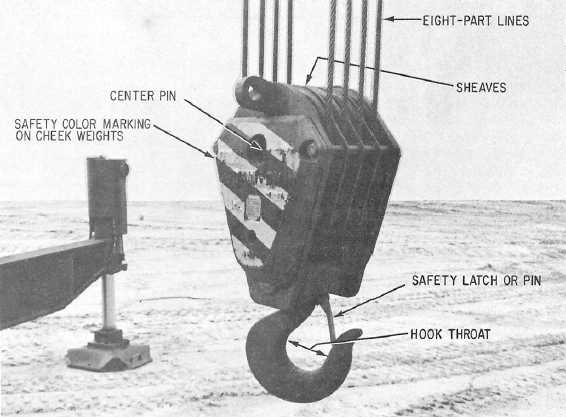boom is at zero degrees or adjusted to read zero
degrees. Measure the radius to avoid any
possibility of error. Take the 48,800 pounds and
multiply it by 110 percent (48,800 x 110% or 1.10 =
53,680). The test weight for this crane example is
53,680 pounds. After the test weight is figured,
you must remember that the hook blocks and
rigging gear are weight that are part of the test
weight.
The number of parts of line rigged on the crane
is important (fig. 3-13). Most load charts will have
the rated capacity of the crane for different parts
of the line; for example, a crane that is capable of
being rigged with a eight-part line is rigged with a
six-part line. Check the load chart for the six-part
line capacity; take that rated capacity and
multiply it by 110 percent. The answer will be
your test weight.
Another weight to figure is the weight for the
stability test. The stability test requires that the
maximum test load be lifted first at the maximum
radius and then be swung through each
manufacturer’s
recommended
quadrant
of
operation for the crane, which is normally over the
side and rear. Using the load chart (fig. 3-11) with
the crane assembled with 60 feet of boom, the
maximum radius is 55 feet. Note on the load chart
a rated capacity for over the rear and over the
side. Since the weight has to be transferred from
one quadrant to the other as part of the test
procedure, use the recommended capacity for over
the side. You will find on some load charts the
rated capacity will be the same for over the side
and rear. The rated capacity for this example is
8,400 pounds. Multiply the 8,400 by 110 percent
(1.10). (8,400 X 1.10 = 9,240.) In this case, the
stability test weight is 9,240 pounds. After the test
weight is figured, you must remember that the
hook blocks and rigging gear are weight that are
part of the test weight.
A third test weight to compute is the test
weight for the auxiliary line, commonly known
as the whip line. This test weight is computed
by the maximum load capacity for the winch
hoist or the safe working load (SWL) of the
wire rope installed on the winch. You must
remember that when the winch capacity is
Figure 3-13.—Eight-part line hook block.
3-14


